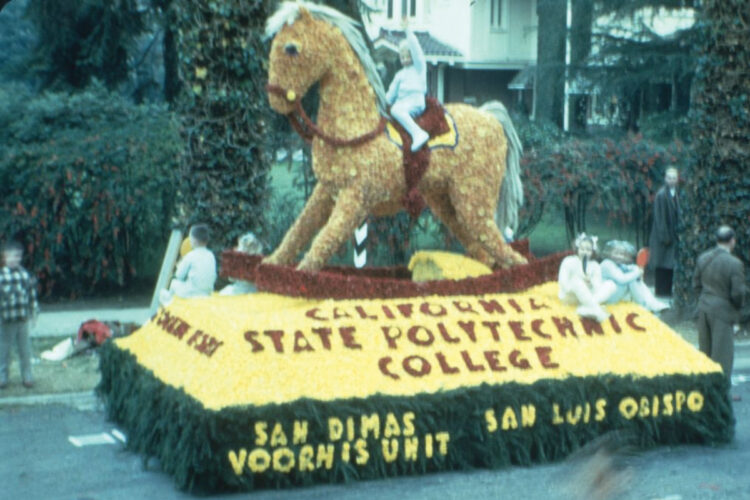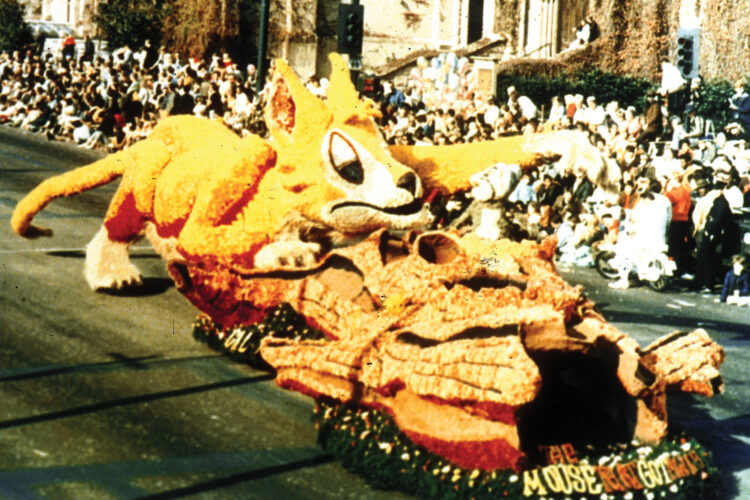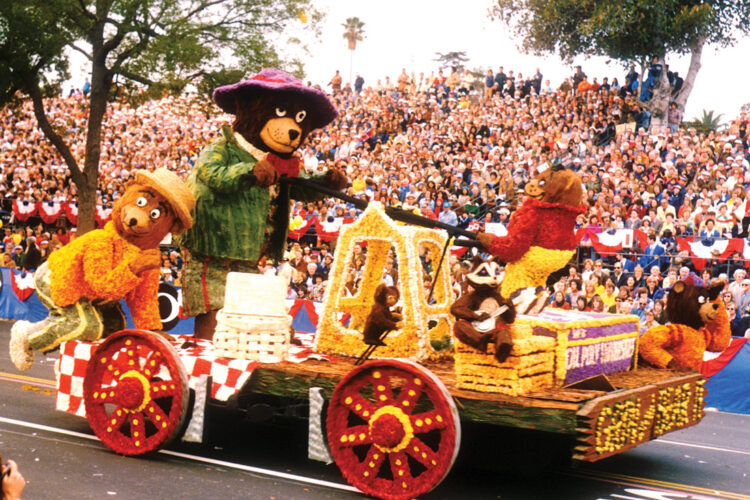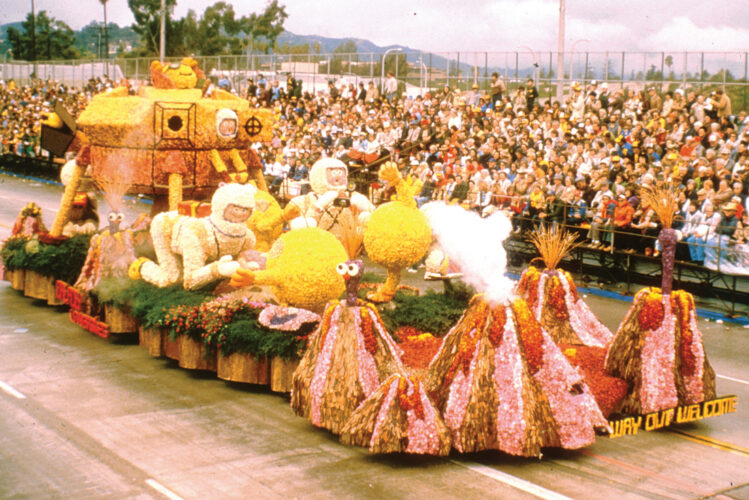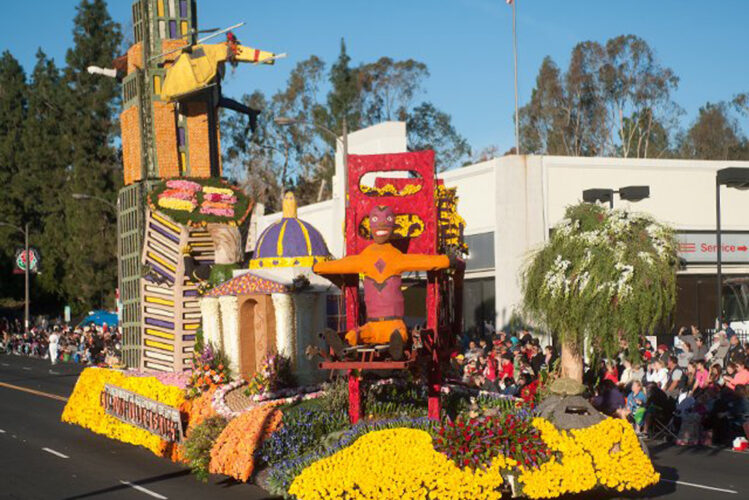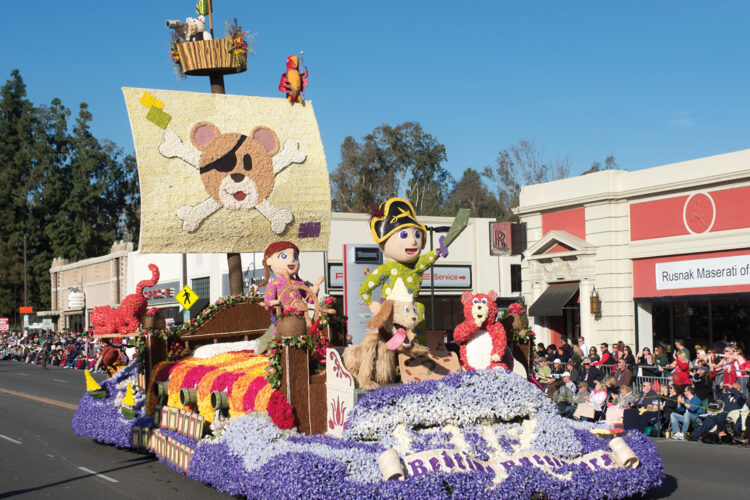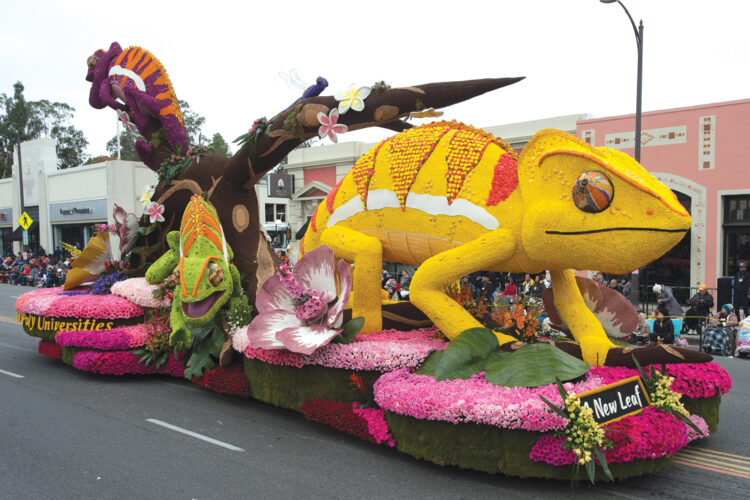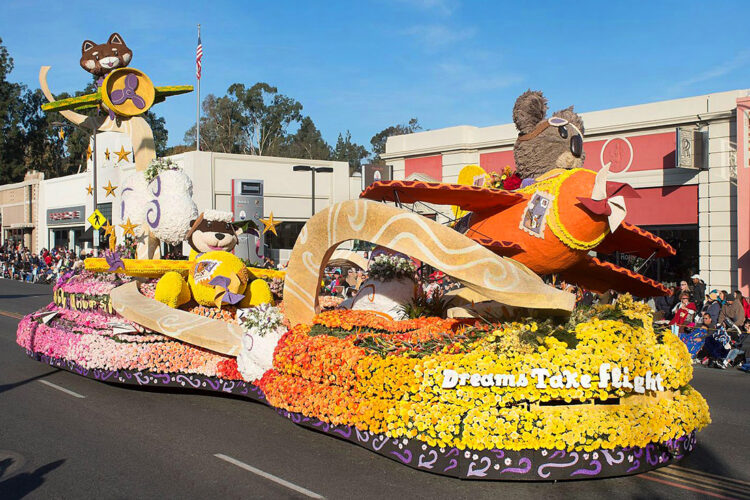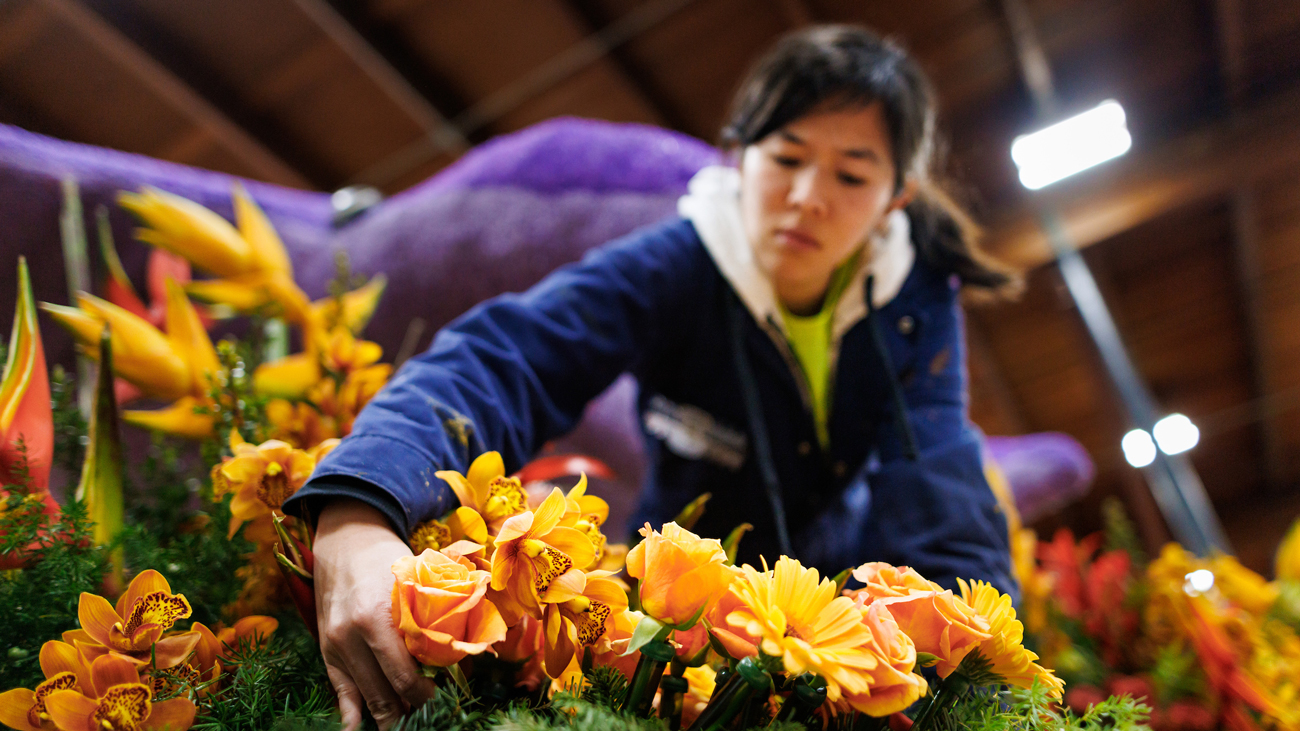
In the wee hours before the 2023 Rose Parade®, Collin Marfia was starting to panic.
Cal Poly’s majestic float, “Road to Reclamation,” was decorated and in position to wow thousands of parade spectators and millions of broadcast viewers around the world. A key part of Marfia’s job as drive engine operator was to get the float started so it could begin its five-mile route through Pasadena. But the engines sat silent, unable to turn over.
“My heart fell out of my body,” Marfia remembers, as if it happened yesterday.
Despite the icy morning temperatures, he began to sweat as he saw parade officials walking over to investigate the delay. So Marfia threw a Hail Mary: he turned off the lights and the team’s communications system to conserve battery. There Marfia sat — in silence and in darkness — pleading for the engines to work. A few heart-stopping moments later, the eerie stillness was shattered by the roar of the float’s engines and Marfia’s giant sigh of relief. He flipped switches and hopped in with his fellow operators.
“It didn’t hit me until halfway through — when we were getting closer to the end — that, ‘Oh my God, this is a defining moment in my life. I’m on international TV right now!’” Marfia recalls. “I just didn’t realize because I was so focused on making sure it worked.”
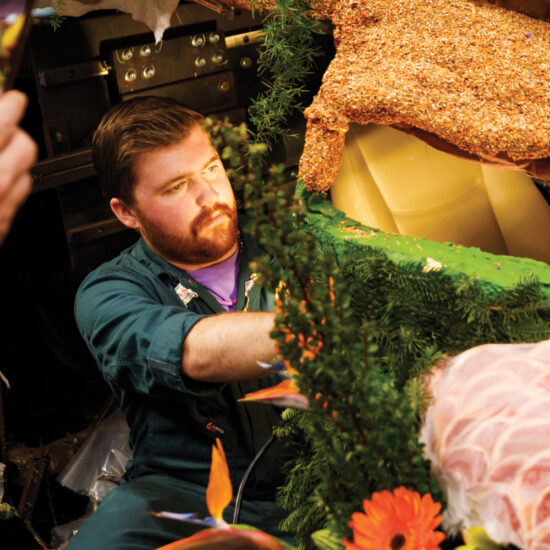
Collin Marfia inspects components of Cal Poly’s 2024 float during deco week. Photo by Joe Johnston
Marfia is just one of countless students throughout the Rose Float program’s 75-year history to experience a mettle-testing, life-defining moment while creating a work of art that showcases Cal Poly ingenuity to the world.
Beyond the flowery exterior, the floats — and the legacy of the program itself — represent a polytechnic blend of agriculture, design, engineering and leadership. Fueled by a culture of friendship, students proudly build on innovations handed down through generations to shape a learning experience that shows no signs of wilting.
“This is one of the absolute best examples of Learn by Doing,” advisor Josh D’Acquisto said. “For us to get the opportunity to present that to the world — that’s everything.”
The First Cal Poly Rose Float
The inaugural float was the brainchild of Cal Poly Pomona student Don Miller, who approached the Tournament of Roses® in 1948 asking to participate with less than 100 days before Jan. 1. Along with students and faculty from both San Luis Obispo and Pomona, Miller pulled together a budget of $258 to create a simple but endearing rocking horse that won the parade’s Award of Merit in 1949.
In the early years, San Luis Obispo’s team focused on fundraising and supplied volunteers for deco week, the late December effort to apply flowers to the float body right before the parade. In Pomona, students handled much of the float design and construction before the collaborative decoration effort.
When the campuses split to become Cal Poly and Cal Poly Pomona in 1966, the collaboration endured and student participation grew, especially in San Luis Obispo. Despite logistical and communications challenges between the teams, the new dynamic bred bold technical innovations that changed the Rose Parade forever.
Use the arrows on the images below to scroll through history-making Rose Floats.
Innovative Animation
The universities’ 1968 entry, “The Mouse That Got Away,” set the stage for two important milestones: the parade’s first use of hydraulics to power animations, and the first time part of the float was constructed in San Luis Obispo. The design featured a clever mouse outwitting a hungry cat by popping in and out of the float’s body to dodge its swatting paw.
Elizabeth “Leisa” Swanson (English ’68) was in charge of forming the mouse’s head out of clay mâché. She recalls exhausting work and frigid temperatures — but also a warm sense of camaraderie and pride in the award-winning float — as she and the team applied flowers late into the night.
“It was the amazing teamwork that I was so inspired by. We were all working elbow to elbow to make something happen,” she says, tears welling just as they did back then. “There wasn’t anything like this — I never had a total experience of starting off from scratch and putting something together.”
The next generation took that boundary-breaking approach a step further. The “Tons of Fun” entry in 1977 featured a roller-skating mother elephant towing her calf in a red wagon. The playful, two-piece design was made possible by a reimagined hydrostatic drive system pioneered by students in San Luis Obispo, including Peter Hames (Engineering Technology ’79), who became the program’s first hydraulics chair.

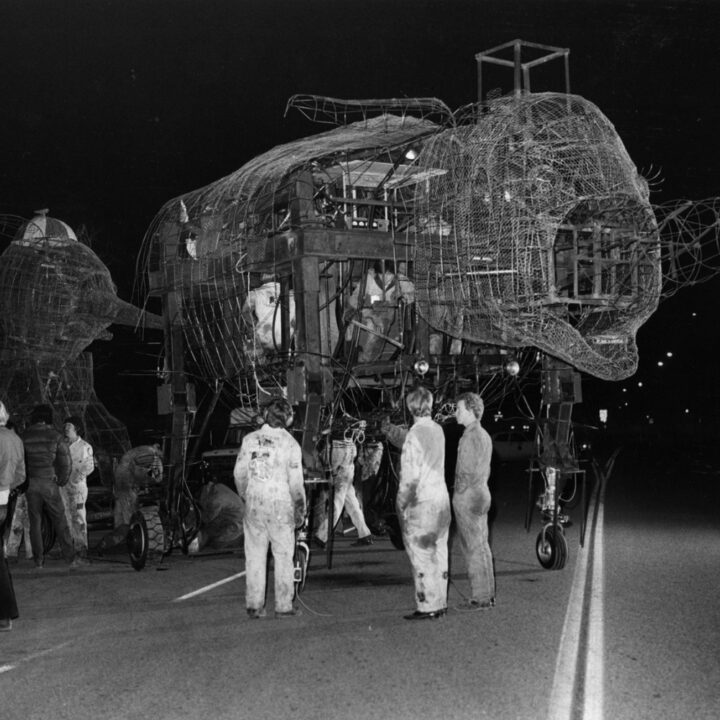
We really didn’t understand what wasn’t possible,” said Hames, who served as construction chair, vice chairman and San Luis Obispo’s first float operator during his six-year tenure. “In some areas, we probably had more time available to perfect a piece of animation compared to a professional company bringing in a highly paid consultant.”
The 1977 float kicked off a run of award-winning, fanciful designs that pushed the boundaries of the parade with computer-controlled animation and fiber optics. Hames credits the steady stream of students who eagerly introduce innovative technologies they learn about in class.
All of these advances — which included many firsts for the parade as a whole — amplified the team’s creative concept while illustrating Learn by Doing on a grand scale.
“You need to have a design element that is going to attract the television cameras — whether that is some unbelievable use of floral materials or really unique motion with a humorous story behind it,” Hames says. “Maybe instead of 15 seconds, it’s going to get 30 or even 40 seconds of time on TV, and that will give the television commentators more time to tell the Cal Poly story.”
Locally Grown Flowers
Each new generation puts their own spin on their floats — but some big ideas reshape the program’s trajectory. One of those ideas came to environmental horticulture student and decorations chair Katie Ford while she prepared flowers for the 2007 “Arctic Antics” float.
“As we were stripping these imported roses, the pesticides were making our hands red and swollen,” Ford remembers. Ford joined the program because of her serious passion for flowers, and she yearned for the quality of blooms she saw growing in California to make the float’s design come alive. As she soothed her irritated hands, she had an idea.
“The parade was founded on this idea to show off California roses,” she said. “In the winter, we have this wonderful weather that produces crops and flowers. So I’m like, ‘Why are we not showcasing California roses from the floats?’”
Ford cultivated a relationship with the California Cut Flower Commission and set a goal to use as much locally grown flora as possible. When the state’s growers heard about the effort, they donated roses for the 2008 float, “Guardians of Harmony,” which illustrated a dragon elegantly sweeping past a lush waterfall adorned with fresh blossoms.
A few years later, Kelsey Schmiedeberg (Landscape Architecture ’12) restarted the effort to grow flowers on campus in San Luis Obispo, much like Cal Poly Pomona has done for decades. Today, a flower field off Highland Drive grows marigolds, strawflower and statice that students dry for textural elements — adding to the push for local flora.
Students like Ford and Schmiedeberg set Cal Poly on a path to becoming one of the first Certified California Grown floats in the parade in 2012, signifying that at least 85% of a float’s floral materials are grown inside the state.
How a Float Comes to Life
After decades as a student club with fundraising obligations, Rose Float became an official program of Cal Poly under Associated Students, Inc. in 1999. The transition included an annual budget and an advisor. It also meant that students could focus their energy on building more creative entries and engaging new students.
Since filling the advisor role in 2006, D’Acquisto watched participation explode from a few dozen students to more than 400 students from each campus.
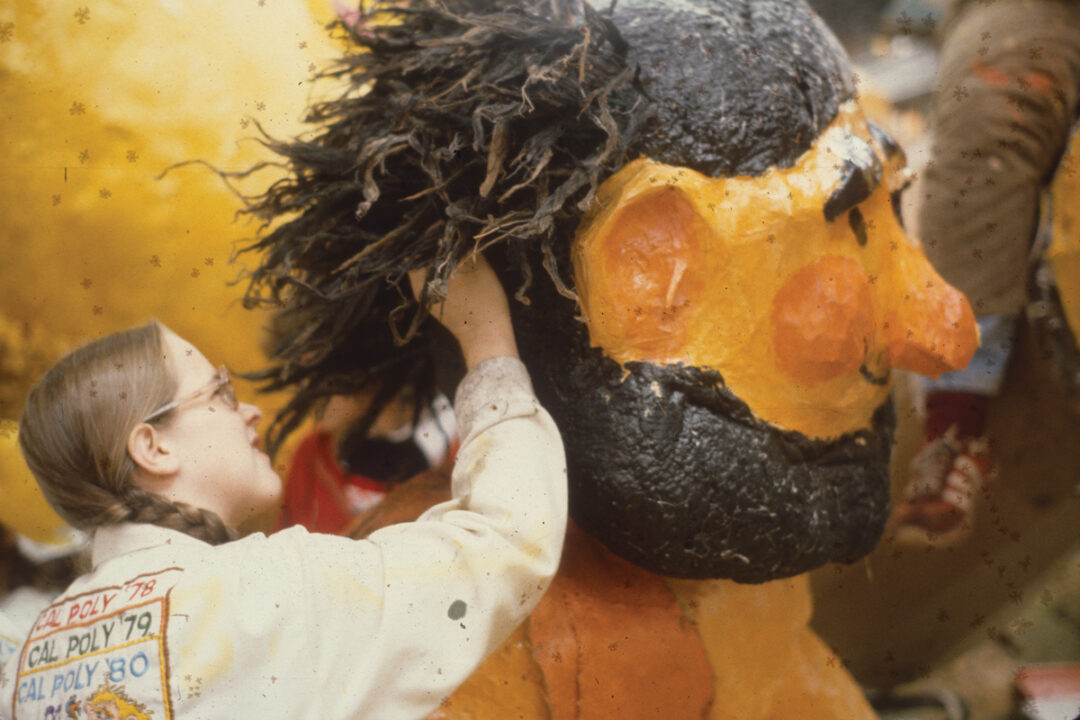

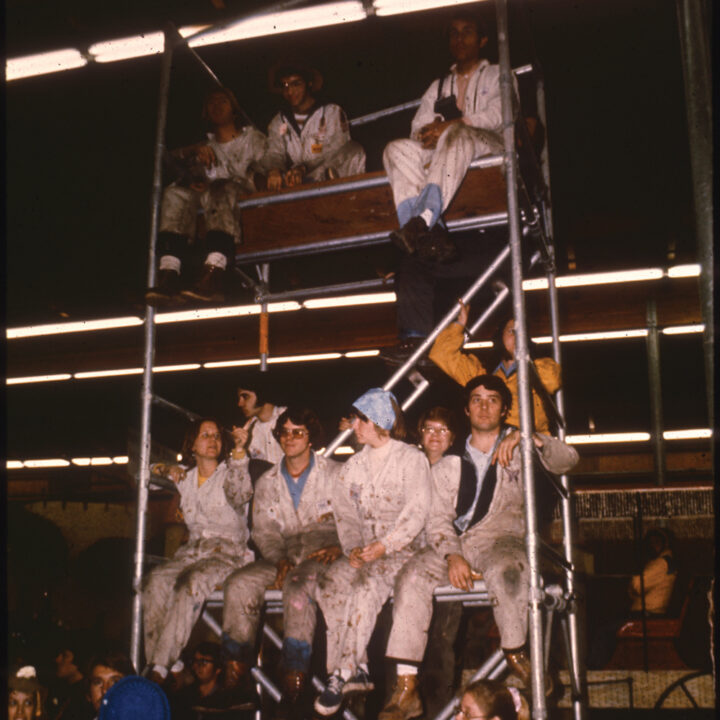
“I like to say that the Rose Float program is a student leadership development program that happens to produce a float for the Rose Parade,” he says. “This is a learning tool: building this absolutely massive project on this strict timeline that’s immovable. That parade is kicking off at eight o’clock in the morning on the first, whether you’re ready or not.”
Each new parade theme challenges students to deliver a professional product while juggling full-time academics — and push the envelope while they’re at it.
“I sit in these brainstorming meetings, and I’m always amazed,” says D’Acquisto. “We’ve been doing this for 75 years. How do you continue to find things that we’ve never done before? That impresses me, and that is the culture of this program.”
After the team deconstructs its float in January, they accept concept submissions for next year’s creation. A committee molds the rough ideas into a workable concept based on the parade’s theme, then into formal renderings, construction schematics and detailed floral plans.
“There’s a narrow window from February through May to dream big, and then it’s time to stop talking about it and turn in those plans to the Tournament of Roses,” D’Acquisto says. Students have to sell parade officials on their vision, which can involve convincing them to bend the rules to introduce a new feature.
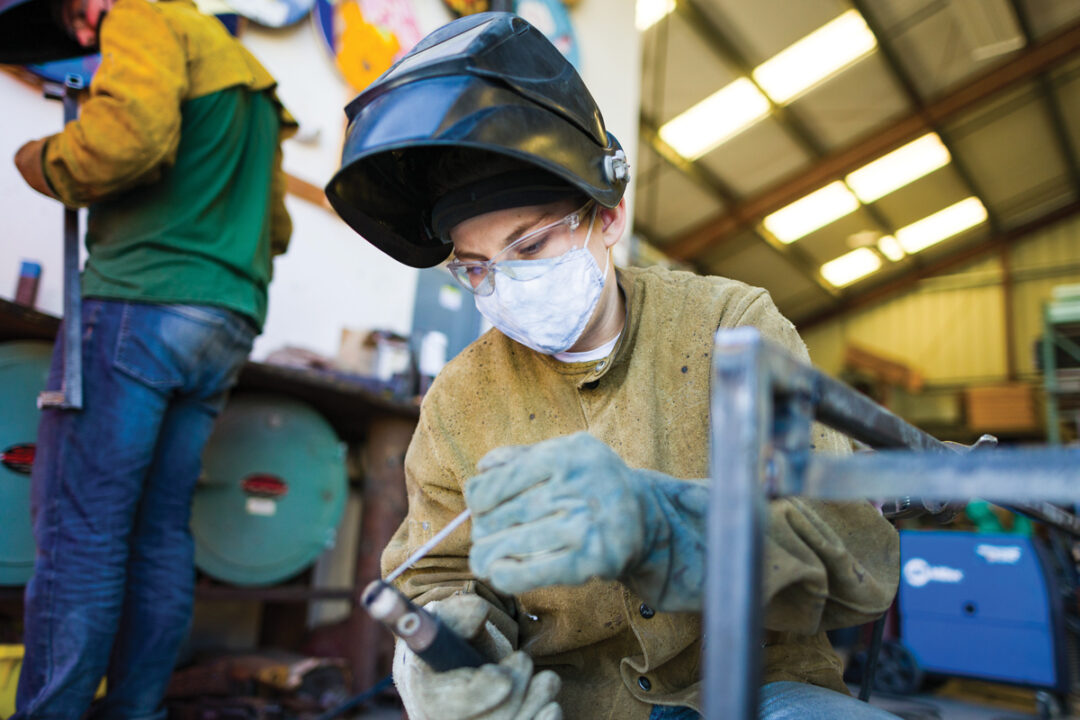
Over the summer and fall, the Pomona and San Luis Obispo teams each take half the float’s base and begin construction. The two parts are joined together in Cal Poly Pomona’s Rose Float Lab, requiring students from San Luis Obispo to drive the six-hour round trip every weekend for months of meticulous pencil steel shaping, foam application, mechanical testing and flower field harvesting. After students complete their final exams in fall, they move all operations to Pomona for design week, when the float body is painted and inspected. Then students tow the float to Pasadena in preparation for deco week, which culminates in a final judging by parade officials.
“It’s a rigid process that allows for this amazing innovation and creative exploration, but then they have to deliver it in a very professional package — and that is where a tremendous amount of learning goes on.”
Building Skills and Friendships
What keeps students coming back to such a demanding extracurricular activity? It’s the people.
“I just really wanted to keep spending time with everyone because it is such a passionate, geeky, excited, intelligent group of people,” said Quinn Akemon, plant sciences student and president of Rose Float in 2023. “I can walk into the Rose Float Lab and every single person there is my friend. Even if I’ve never met them before, I just know that I can get along with every person in that building.”
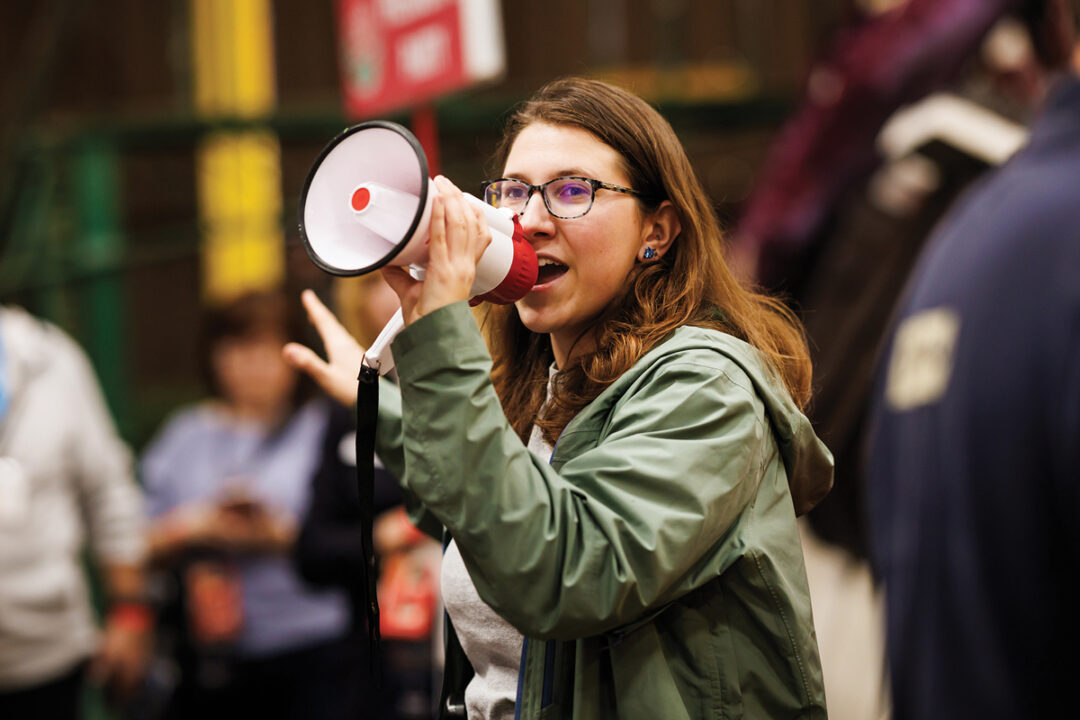
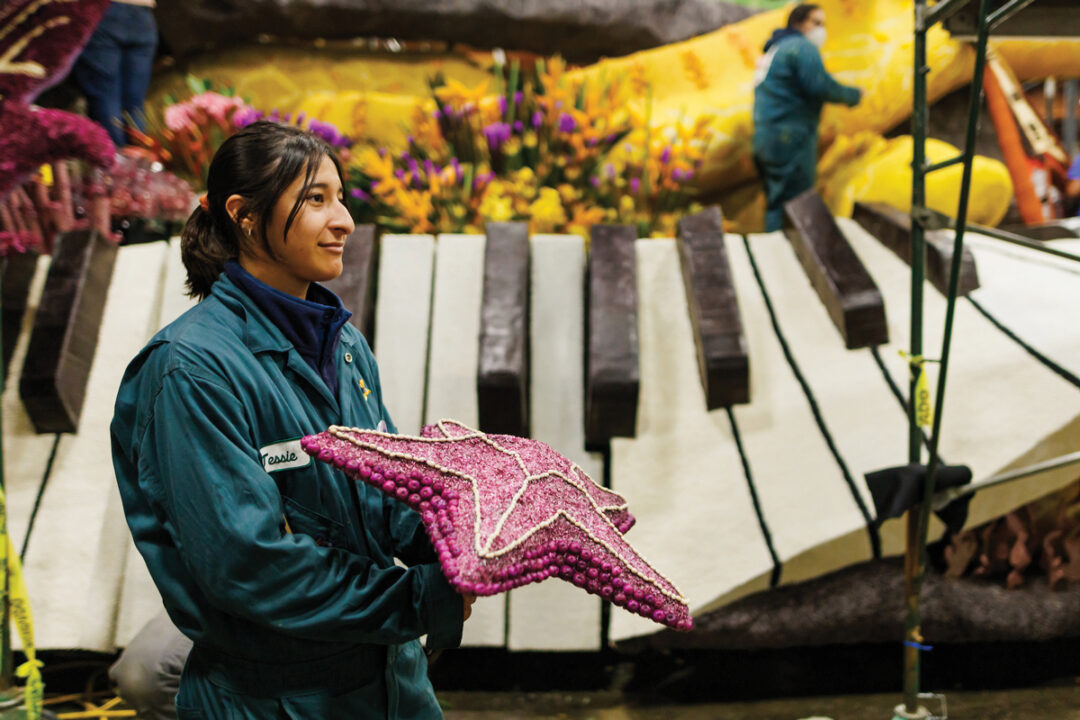
Collin Marfia, who served as vice president alongside Akemon, recalls feeling shocked during the program’s open lab day when program veterans encouraged the history major to learn about the band saw. After being thoroughly trained, he went on to specialize in some of the float’s construction elements. Having friends helped Marfia embrace those new challenges.
“I knew I wanted to spend my time in Rose Float with how willing they were to have me involved and how much they seemed to want me there — they were just so welcoming,” Marfia says.
While students add technical skills to their resume — from welding to ornamental horticulture — many float builders notice a change in their self-esteem.
“I’ve become more decisive than I ever really was before,” Akemon says of their years in leadership roles. “It’s very empowering and has given me a lot of confidence. I really feel like I can walk in pretty much anywhere and find my people, make those connections and make a team out of wherever I am.”
After Mustangs like Akemon graduate, they continue connecting with their fellow float fanatics through an alumni network led by Ian Davison (Mechanical Engineering ’16). The group gathers throughout the year and raises money to support the current team of float builders with social outings, networking barbecues and meals during the long hours of deco and design weeks each December.
Davison says alumni also flex their expertise hosting skills workshops where they can share institutional know-how. “When a student team is really green, we will call upon some select members of the alumni community who have strengths in construction, decorations or steel sculpture and say, ‘Hey, the students would like your expert advice — tell them how you did it,’” he said.
After a program defines so much of someone’s college experience, Davison says it’s no surprise alumni want to give back.
“We value the experiences, we value the friendships, the bonds created,” says Davison. “That shared experience still ties a lot of us together, and it’s something that a lot of us like to come back to.”
Alumni Career Paths
Rose Float alumni learned more than just how to build parade floats. Graduates tackle an eclectic variety of careers, including rocket science, photography, marketing, landscape architecture and software engineering.
Peter Hames, who helped pioneer the 1977 float, caught the attention of NASA managers when he worked alongside them on the city of La Cañada Flintridge’s self-built float. Now part of NASA’s Deep Space Network team, Hames credits his Rose Float experience for laying the foundation for his 40-year career with the Jet Propulsion Laboratory.
Hames says graduates with Rose Float experience have a significant edge that hiring managers want.
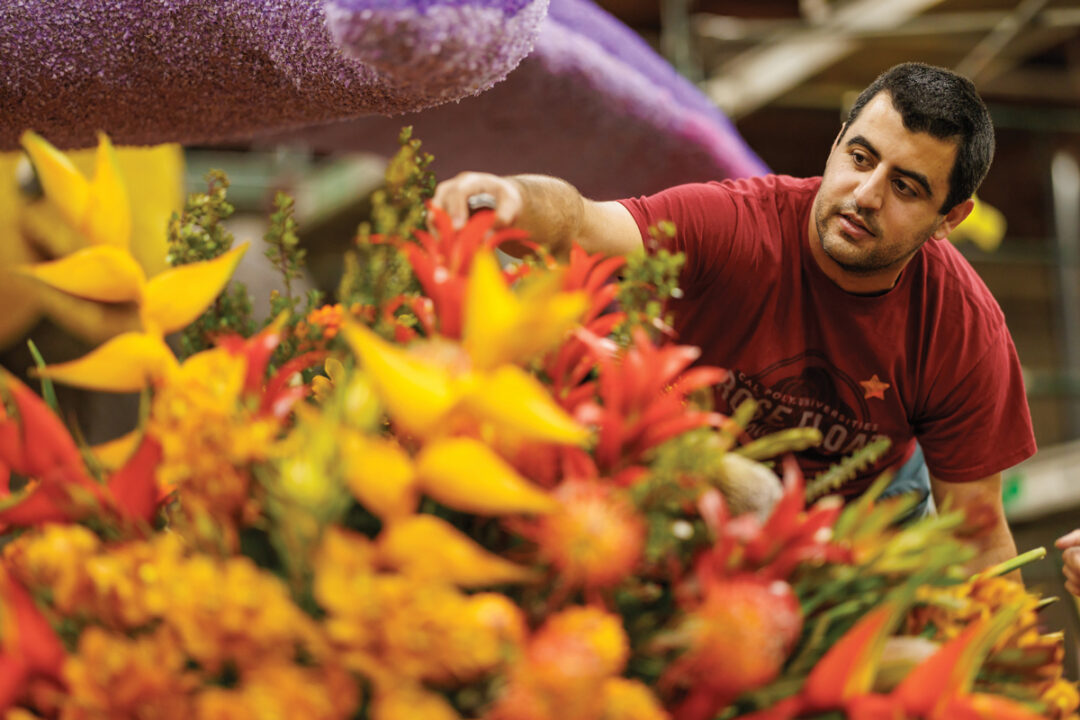
“They can multitask and get involved in a number of different disciplines, and I think that is a major part of the Learn by Doing experience,” Hames says. “That’s why I got the job offers I did after graduation — because people in interviews were aware that I could talk about leadership experience.”
Through his years of experience, Hames says Rose Float fosters the ability to respect a deadline.
“As the date gets closer, you need to prioritize open tasks and make real-time decisions on how to manage tasks to meet the date,” says Hames.
For Sergio Dimas (Animal Science ’18), a deputy city prosecutor in Long Beach, California, Rose Float taught him to communicate effectively. “I ask questions frequently and consult with my colleagues to determine our next step,” he says. “In Rose Float, it was more about timelines and how progress on one thing might hold up something else. It’s quite similar here!”
Philip Siongco (Civil Engineering ’07) says watching the different departments collaborate to make a harmonious product has stayed with him as he became a civil engineer for Los Angeles County. “Rose Float exposed me to networking and how to be part of a committee,” he said. “It grew my project management skills I use when developing and constructing public works projects today that depend on so many people to serve the community with essential infrastructure.”
Katie Ford says her boundary-pushing deco chair experience in the early 2000s means she has unmatched time management skills.
“Once you do a deco week, you can do anything in a week.”
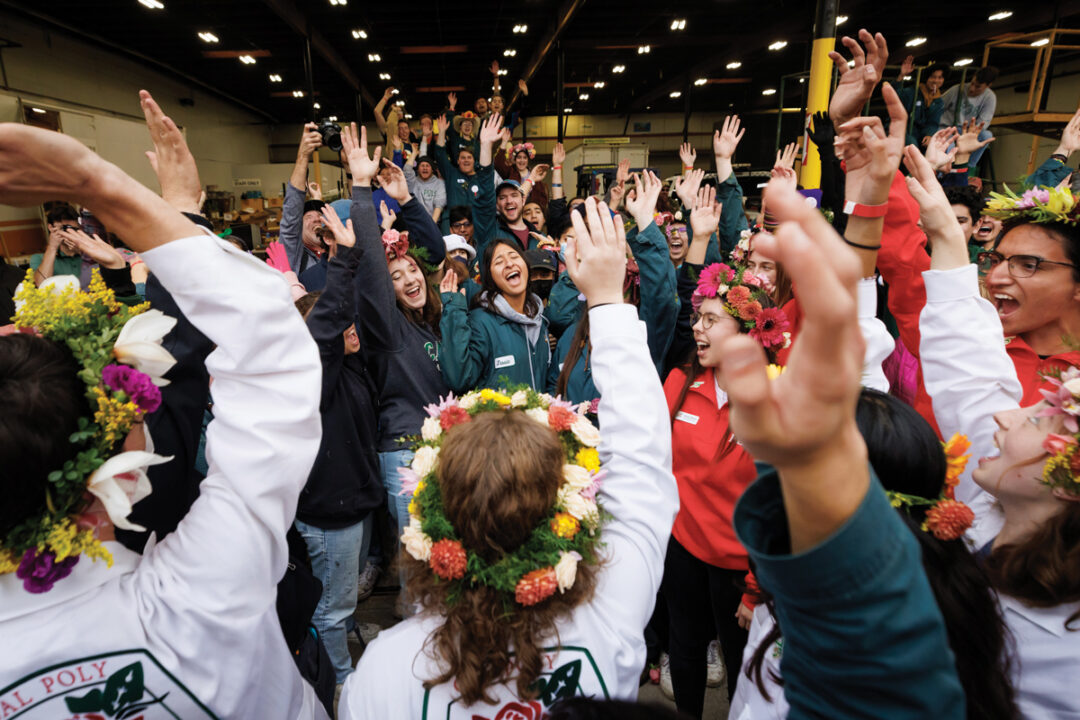
The Parade’s Future
The program has stood the test of time, persevering through ups, downs and even a pandemic while earning 62 trophies. But what will the next chapter look like?
“Things are going to change in the next 10 years,” says D’Acquisto, citing the evolution of the Rose Bowl® football game and the quest to capture a new generation of parade viewers.
“Cal Poly’s involvement — I’m not concerned about that. There will be excited students ready to take on a new challenge and do it differently.”
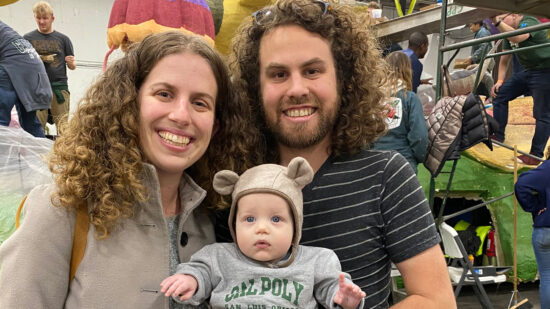 Your Next Read
Your Next Read
Many Mustangs meet lifelong friends and spouses through their time building floats, but one family may have the strongest connection of all. The Ahlstrom family boasts two generations of float leaders whose romances blossomed through the program.


